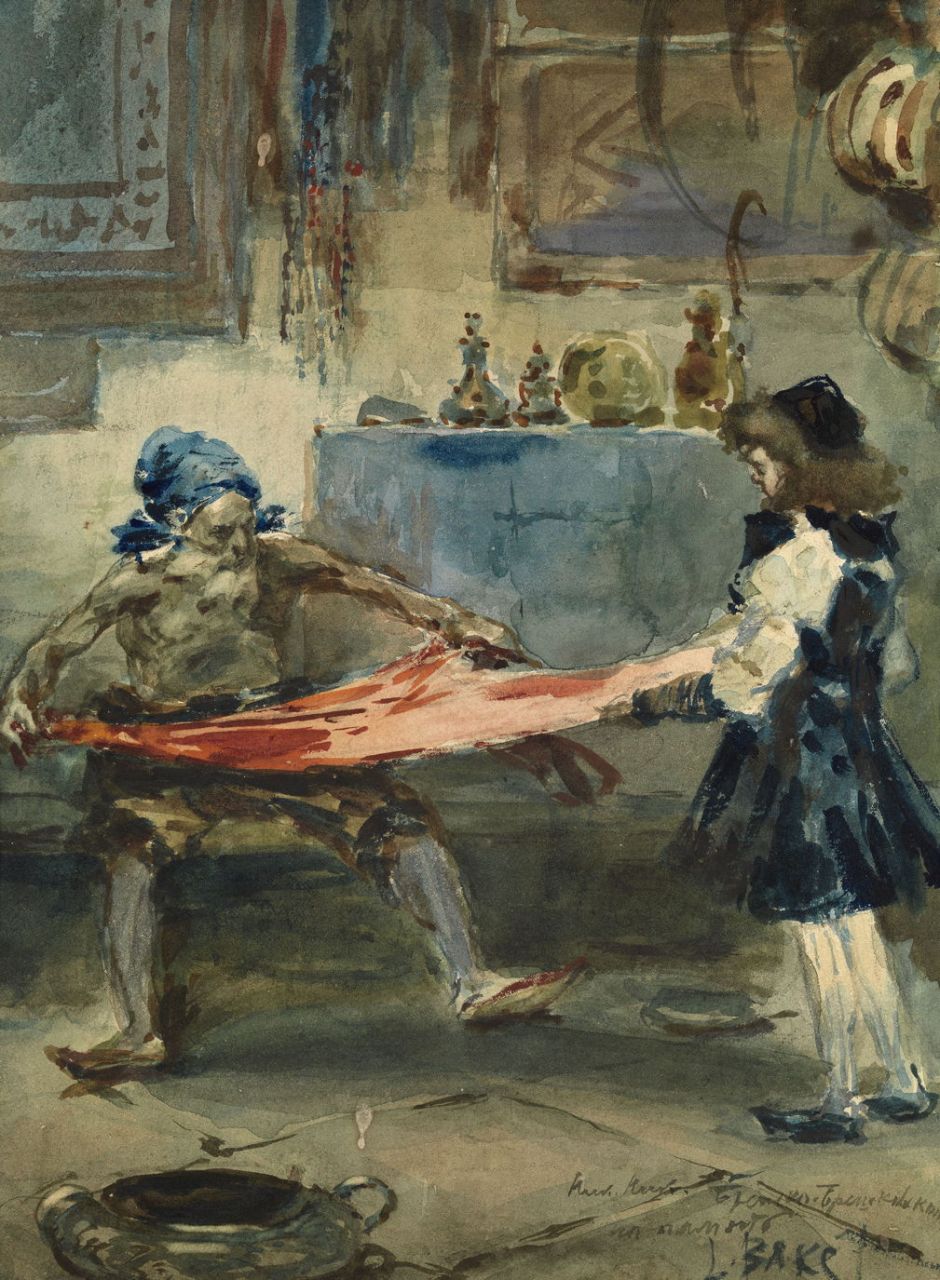In the late nineteenth and early twentieth centuries, many talented and successful artists painted and designed for theatres, operas and ballets, which flourished across Europe and North America. Among the most famous were Gustav Klimt and Alphonse Mucha. Among them was the Belarusian born as Leyb-Khaim Izrailevich Rosenberg but best known as Léon Bakst (1866–1924) – in Cyrillic Леон Бакст.
Bakst was born into a Jewish family in Grodno, then part of the Russian Empire. His family were prosperous tailors who had enjoyed royal patronage. He decided he was going to be a painter when he won a drawing contest at the age of twelve, but his family tried to discourage him. Although he failed the entry to the Saint Petersburg Academy of Arts, he studied there as a non-credit student until he finally gained entry in 1883. He specialised in watercolour, and in 1893 went to live in Paris, where he studied at the Académie Julian.

Portrait of a Young Girl is a delicate rendering in watercolour which he painted, apparently for a friend in Paris, in 1897.
In the late 1890s, Bakst was a member of the literary and artistic circle which included Sergei Diaghilev and Alexandre Benois, who co-founded the influential Russian art periodical Mir iskusstva, for which Bakst produced graphics.
During these years, he appears to have painted mostly portraits.

This Portrait of Countess Maria Alexandrovna Keller, which he painted in 1902, shows the former Princess Shakhovskoy (1861—1944), who was a member of High Society prior to the revolutions.

He also seems to have painted the occasional watercolour landscape, such as this View with Cypress Trees from 1907.

His undated Oriental Scene is a brilliant watercolour sketch which looks as if it might be a scene in a play, and is dedicated to another friend.

Terror Antiquus, meaning ‘Ancient Horror’, is a more painstaken painting from 1908, expressing what must be angst if not apocalypse.
That year, Bakst started painting and designing for Diaghilev and his newly-founded Ballets Russes, which toured Europe and the Americas. Diaghilev was very successful, and commissioned music from Igor Stravinsky, Claude Debussy, Sergei Prokofiev and other major composers of the day. Other painters who produced work for the Ballets included Vasily Kandinsky, Pablo Picasso and Henri Matisse. Coco Chanel also created costume designs.

During his fourteen years working for the Ballets, Bakst painted many set designs in watercolour, such as this for Les Orientales in 1908. Although quite small, each of these reveals an imaginary world into which the ballet was set.

He also designed many costumes, including those for leads including Mme Ida Rubinstein, shown here in his watercolour portrait of her from about 1910. Rubinstein (1883-1960) danced with the Ballets Russes during her early career, between 1909-11.

Bakst’s preliminary watercolour study for the décor of the ballet Le Dieu bleu (The Blue God) in 1911 is another adventurous painting.

This costume design for the character Pretres Agni in The Blue God is interesting for Bakst’s use of the relatively new pigment of cadmium yellow.

Bakst also designed this costume for the ballerina Anna Pavlova, for The Butterfly in 1913.
He remained a ‘pure’ artist too, and before the First World War taught painting in Saint Petersburg, where one of his favourite students was Marc Chagall. In 1913, he was commissioned to paint seven panels for the English mansion of James and Dorothy de Rothschild.

He painted The Sleeping Beauty: The Prince Discovers the Princess and Wakes Her with a Kiss (1913) in oils. It can now be seen in Waddesdon Manor, Buckinghamshire, alongside the other six paintings in this series.
In 1914, Bakst was elected a member of the Imperial Academy of Arts in Russia.

Bakst’s design for a young woman in a red bonnet, for Ballet Boutique Fantasque in 1917, is one of relatively few paintings which have been found to contain cadmium orange, obtained by adding small amounts of the even more novel selenium to cadmium sulphide.
Bakst didn’t fare so well from the 1917 Revolution, though. His sister died of starvation, and he fell ill as result of the grief and stress. His own money was stolen by his servant, who also coerced him into writing her into his will. In 1922, he broke off his long-running relationship with the Ballets Russes and concentrated on exhibiting his work in America, and interior design.

He apparently continued to paint portraits in the years following the 1917 Revolution. He completed this Portrait of Rachel Strong, future Countess Henri de Buazhelen in 1924, against a background which could have been one of his stage sets.
Léon Bakst died in Paris just after Christmas that year.

